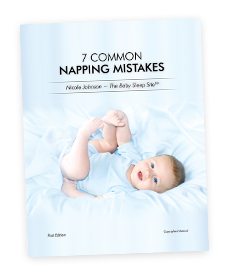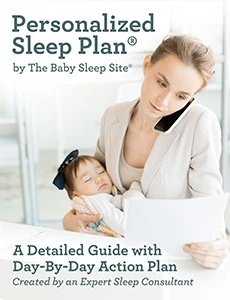
We know, parents, we know – judging by what we’re hearing from many of you in our Helpdesk, naps are high on your radar! You want to know how to make them more consistent, how to make them longer, how to make each nap as restorative as possible! In short, you want to become the Nap Jedis. And we get it! A great nap schedule is, after all, one of the keys to sleeping through the night!
 If you’re struggling with short and inconsistent naps, you’ll definitely want to take a moment to download our free nap guide. It’s a great, easy-to-read guide that walks you through some of the most common napping mistakes we parents tend to make, and offers tips on how to solve them.
If you’re struggling with short and inconsistent naps, you’ll definitely want to take a moment to download our free nap guide. It’s a great, easy-to-read guide that walks you through some of the most common napping mistakes we parents tend to make, and offers tips on how to solve them.
You’ll also want to keep reading this article. It lays out 25 nap time tips you can start using as early as your child’s next nap!

25 Nap Time Tips You Can Put To Use Today – As Early As Your Child’s Next Nap!
- Don’t force a nap time schedule too soon. Most babies aren’t ready for a by-the-clock nap time schedule until around 5 months or 6 months. Forcing your child onto a clock-based nap schedule before then can actually result in over tiredness, which will make overall sleep worse.
- Rigid or flexible nap schedule? Speaking of schedules – all nap schedules don’t look the same, and not all nap schedules work for all babies. Some babies and parents do great with a flexible, relaxed daytime schedule that works more like a rough outline of how the day will go. Other families, however, do better with a rigid schedule that is extremely predictable. And even the same baby may need different schedules at different seasons of life, so be ready to get flexible or tighten up depending on your baby’s development and needs.
- For newborns and young babies – watch sleep cues closely. Don’t watch the clock to determine your newborn’s next nap. Instead, watch for sleepy cues, like yawning, eye-rubbing, staring off into space, etc. If you wait until your baby is fussing, you’ve waited too long. Crying is usually a sign of overtiredness.
- Offer your toddler a snack or meal before nap time. Your toddler’s rapid growth and development (not to mention boundless energy!) burn a lot of calories! So be sure to offer a meal or a small snack before nap time. This will prevent your toddler from waking early from the nap, out of hunger.
- Offer your baby a feeding close to, but not right before, nap time. Toddlers need food fairly close to nap time, but be careful about feeding your young baby right before a nap – particularly if your baby has reflux or GERD. Feed and burp, and then make sure your child is upright for a bit, so that you avoid a mid-nap spit-up session.
- Create a nap time routine. Bedtime routines are great, and nap time routines are, too! Your nap time routine can simply be a shortened version of your bedtime routine. Be sure to do it consistently before each nap, as a way to set the stage for good nap time sleep.
- Avoid screen time right before nap time. TV and sleep do not mix! Avoid having your toddler watch TV or play on an iPad or tablet right before nap time, as it may lead to a too-short nap. End all screen time at least 30 minutes before your toddler’s nap time.
- Avoid too many on-the-go naps. On-the-go sleep (the kind that happens in a carseat or stroller) is less restorative than sleep that happens in the crib. Occasional on-the-go naps are fine, but the majority of your child’s naps should happen at home, or at a caregiver’s.
- For younger babies, work on having one or two naps a day in the crib, if you’re working towards more independent sleep. There’s no rush to work on sleep coaching with your young baby, but if you’re working on helping your baby sleep more independently, aim for the first morning nap (and possibly the first afternoon nap) happening in the crib. You can also work on laying your baby down drowsy but awake during these naps.
- No naps before 8 a.m. or after 6 p.m. For babies older than 3 or 4 months, a good rule of thumb is to have no early-morning or evening naps. Early-morning naps tend to reinforce early-waking habits, and evening naps tend to mess with bedtime.
- Wake your child from a nap that’s going too long. You don’t generally want to wake a sleeping baby(that’s especially true for newborns!), but there are times when you need to wake your child from sleep, and an extra-long nap is one of those times. If your child naps too much during the day, it will almost certainly affect night sleep.
- Avoid letting naps in the infant swing become a habit. It’s fine to use the swing to soothe and relax your baby – and it’s no problem if your child catches an occasional “swing nap”. But avoid letting your baby take the majority of her naps in the swing.
- Catnaps are normal for newborns and young babies and during a nap transition. In general, you want a nap to be around an hour (or more) in order to be restful. If your child’s naps are always 30 or 45 minutes, that’s a problem. However, short catnaps are very normal for newborns. Short naps are also common during a nap transition, such as when your child is working on dropping a nap.
- Know the timing and signs of nap transitions. Speaking of nap transitions – it’s a great idea to read up on when they happen and how to ease the transition for your child. Nap transitions can be tough, but the more you know, the easier they are to manage.
- White noise can be key to making naps last longer. All those daytime noises – dogs barking, phone ringing, traffic bustling – can make it hard for your child to sleep well. White noise is a great way to block out these sounds, and help your child sleep deeply.
- Make sure your nap expectations are reasonable. We find that lots of parents make the mistake of expecting too much nap sleep from their children. So what they see as nap “problems” really aren’t problems at all. Be sure to learn how much nap sleep your child really needs, and keep your expectations reasonable.
- Understand that nap sleep and night sleep are different. Your child may sleep well at night, but that doesn’t guarantee naps will be great. Why? Because nap sleep and night sleep are very, very different, and are handled by different parts of your child’s brain.
- Remember that nap training and nighttime sleep training are different. Speaking of the ways that nap sleep and night sleep differ – remember that the approaches you use to sleep train for nights and for naps may need to be different. You may need to use different sleep training methods, a different pace, etc.
- Find a balance between noise and silence. Creating an optimal nap environment (read: quiet and dark) can go a long way towards lengthening naps. But don’t go crazy with it! After all, depending on your living situation, daylight hours may be noisy around your house! Know that you can’t prevent every disruptive sound. And while it’s true that you probably can’t teach your baby to sleep through noise, you also can’t drop a “cone of silence” over your home at nap time, either! 😉
- Find a balance between light and dark. Keeping your child’s napping area dark can really help produce great naps. This a great way to signal to your child that it’s time to settle down and sleep. But again, don’t go crazy with it. You probably won’t have much luck in making your baby’s room pitch-black at noon on a sunny day!
- Don’t switch to one nap too soon (many parents do!) Many parents make the mistake of assuming that the transition from 2 naps to 1 should happen around 12 months (probably because there’s a little nap regression that happens around that time). But most babies aren’t ready to transition to 1 nap at 12 months.
- Establish “rest time” for your toddler, once he’s done with naps. When your toddler is ready to stop napping, you don’t have to give up your afternoon peace and quiet! Instead, try establishing a “rest hour” for your toddler.
- If you’re sleep training, you may want to work on nights before naps. This is not a hard-and-fast rule, of course. Many families find that it’s easier to work on nighttime sleep first, and then focus on naps once nighttime sleep has improved.
- When sleep training, know how long to work on a nap (and when to give up!) How long you should work on naps during sleep training will vary from child to child. (A sleep consultant can help you figure out the timing that’s best for your child.) In general, you don’t want to spend 2 hours working on one nap! 😉 Instead, work on a nap for a while, then take a break. You can try again, or – depending on your nap schedule – you may need to wait until the next nap time to try again.
- Take “schedule busters” in stride, but don’t let them undo your nap progress. “Schedule busters” like teething, growth spurts, illness, and sleep regressions can destroy your child’s napping habits temporarily. It’s fine to take a break from your usual napping routines to comfort your child. But be sure that you avoid creating any new napping habits you’ll have to undo later.
Get Nap Time Help From A Pro!
Working on nap sleep really stumps some families. (Again – nap sleep is different than night sleep!) But not to worry! If naps are a nightmare in your home, we can help! Our team of expert consultants is ready to offer you compassionate, caring support that is 100% personalized to your unique situation. We will craft a Personalized Sleep Plan™ specifically for your family! And we’ll walk you through every step of the sleep coaching process in a way that matches your goal and parenting style.








